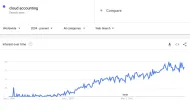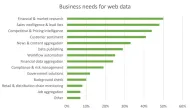Procure to Pay Automation in 2024: Technologies & Approaches
Despite procure to pay (P2P) suites bringing digital workflows and OCR technologies bringing partial automation, P2P has remained largely manual due to its complexity. Manual efforts in the P2P cycle pose a risk in accuracy and reliability as it is subject to human errors.
Given new developments like generative AI, executives are curious to know how they can implement automated P2P workflows using the latest tech developments and improve their control over the P2P. In this article, we will go over:
- 4 technologies to automate P2P
- 2 approaches for a successful P2P automation
- Frequently asked question on P2P & its automation process
4 technologies to automate the P2P cycle
Robotic process automation (RPA)
RPA technology can automate rule based processes in P2P such as:
- purchase request & order submission
- purchase request approval workflows
- inventory management
- automated payments
Intelligent document processing
For example, OCR can empower the use of RPA in P2P process by:
- extracting relevant information from invoices such as vendor data
- extracting data on purchasing information
- creating master records
OCR falls under intelligent document processing which involves the use of machine learning and rules-based automation in document automation.
Artificial intelligence (AI) / Machine learning (ML)
P2P solution vendors are integrating AI in P2P cycles. AI can increase P2P automation rate in use cases such as:
- Sourcing analytics: Current, historical spend data and supplier activity can be analyzed with AI-powered analytics for anomalies and single points of failure (SPOF) to design a more resilient and efficient supply chain.
- Finding suppliers: AI can be used in identification, comparison and invitation of potential suppliers.
- Running real-time auctions: After the identification of potential suppliers, sourcing bots can run auctions autonomously.
- Automating accounts payable processes: APAI can:
- capture invoices & automate the invoice process
- match invoices against POs
- in the absence of a PO, support coding and approval processes.
- Ensuring compliance in accounts payable: AI algorithms can be utilized in monitoring, analyzing and mitigating enterprise spend risks.
Generative AI
A significant share of procurement team’s time is spent communicating regarding deliveries, payments and contracts. Using techniques like retrieval augmented generation (RAG), enterprises can feed payment and delivery status data to large language models which can respond to users queries eloquently. This can be used in:
- Supplier communications
- Stakeholder communications
Which path to choose in automating P2P?
Monolithic approach
P2P suites offer comprehensive solutions that automate most of the stages included in the P2P cycle. Customers tend to purchase P2P services as part of a larger S2P deal with a single vendor. Monolithic solutions can form the foundation of a company’s P2P tech stack however enterprises may want to complement them with other applications to achieve higher levels of efficiency and effectiveness. We cover this approach in the next section.
To find out more practical information on P2P suites, you can check Coupa Alternatives.
Best of breed approach
It is unlikely for a P2P suite to satisfy all the requirements of a global Fortune 500 at an optimal level. Implementation of AI in P2P with a best of breed approach can help solve this. There are some signs to support the shift:
- P2P suite Basware claims that no vendor can offer a full procure to pay suite that is best in class across all modules.1
- Gartner says “organizations should focus on finding solutions that fits your buying organization’s needs as closely as possible. This means that, in many areas, it makes sense to consider alternative specialist solutions to replace or — in some cases complement — the suite offerings.”2
FAQ
What is Procure to Pay?
Procure to Pay cycle comprises a series of steps for buying goods from the selection of vendors to accounts payable. Its stages are customizable and can be adjusted to a company’s needs. It includes:
- Invoices from different systems,
- Processing them,
- And paying them.
These steps are highly appropriate for partial or full automation. P2P automation can accelerate the whole business process, reduce errors, and eliminate compliance risks.
What are the stages of Procure to Pay?
P2P cycle includes stages:
- Budgeting
- Need identification:
- E-purchasing:
- creation of purchase requisition
- sending purchase orders (PO). This is an optional step as in most companies not every order is accompanied by a PO.
- receiving goods or services
- Employee expenses
- Accounts payable
- Matching invoice and PO (2 way match)
- Matching invoice, PO and received goods or services (3 way match)
- Sanctions screening
- Fraud detection
- Supply chain financing (SCF)
- Payments
Automation in P2P cycles are also enabled by:
- analytics
- workforce management
- inventory management
- supplier information management
What are the benefits of automated P2P?
Automation streamlines the P2P process and provides critical benefits from compliance to data management. Other benefits include, but are not limited to, the following:
1. Accelerated, less manual processes with nearly no errors
P2P processes include many manual workloads which require effective and careful management. Any errors in any step such as mistyping a figure or duplicate invoices can cause delays in the whole P2P process.
With automation, P2P businesses can eliminate manual processing steps such as online purchase requisitions and invoice approval processes. Automated P2P solution replaces error-prone, repetitive, and time-consuming tasks and offers more accelerated and errorless processes.
2. Improved visibility with spend analysis
When data is analyzed, it gives insights into strengths and weaknesses. Collecting and analyzing data helps businesses to understand and control their expenditures. This helps them collect, analyze and visualize data about their spending and have improved insights.
It also helps businesses to improve cost savings. While businesses can avoid unnecessary spending, they minimize the risks of erratic procurement spending.
3. Assured compliance
Automated P2P solutions help businesses enforce and guarantee compliance. The software can connect to the government databases to get the most recent regulations, that might go unnoticed by the staff, to apply to transactions. In another way, accountants can manually include regulations for the solution to follow in the purchase order approval system. This way, businesses can stay compliant and avoid fraud.
Explore compliance automation in more detail.
4. Effective supplier management
Automation of P2P simplifies supplier relationships. It provides ready-to-use information from the suppliers. Specifically, it allows businesses to contact them, and exchange information and paperwork. Having seamless and effective communication between buyers and suppliers accelerates procure to pay processes, minimizes waiting times, and reduces the likelihood of shipping delays due to missed payments.
4 steps for an efficient automation of P2P
For a successful automated P2P solution, businesses can consider the following best practices:
1. Automate repetitive P2P processes
The very first step toward the P2P process is to start to look for repetitive tasks that you carry out in a cycle. These tasks require manual effort, are time-consuming, and can be automated for increased efficiency. For example, repetitive manual processes such as bank reconciliation or invoice issuing can be replaced with automation.
2. Integrate P2P solutions with your existing systems
To increase data exchange (EDI) between your existing systems and automated P2P solution, an important step is their integration. Integration with your ERP, CRM, etc. can help businesses to import data and process it fast. Besides, since it removes manual data entry, it can reduce the risk of human errors.
3. Choosing the tools that can automate most of the process
Choosing the correct tool is another critical step for the success of the automated procurement solutions. The right tool must have all-in-one solutions – such as P2P suites– and save you from spending extra costs such as integration tools etc. In addition, it must offer compliance and risk management features.
4. Look for how P2P can be further improved
For a successful automation experience in the procure to pay process, businesses must have an innovative perspective. To enhance automation, and reduce as much manual work in the P2P processes as possible, businesses have to constantly look for and analyze manual processes and evaluate them in terms of automation.
Further Reading
To learn more about finance automation, feel free to read our articles:
- Finance Automation : Use Cases, Technologies & Benefits
- 4 Use Cases & 5 Benefits of Financial Close Automation Software
- Top 4 Use Cases of Automated Bookkeeping
If you are looking for automation tools, you can visit our hub for the automation software landscape.
If you have other questions about procure to pay automation, we can help:
External links
- 1. “The Rise of Ecosystem in Procurement and Sourcing”, Basware, Retrieved on September 17, 2023
- 2. “Don’t Assume You Have to Use an S2S Suite to Digitalize Procurement and Sourcing”, Gartner, Retrieved on September 23, 2023

Cem has been the principal analyst at AIMultiple since 2017. AIMultiple informs hundreds of thousands of businesses (as per similarWeb) including 60% of Fortune 500 every month.
Cem's work has been cited by leading global publications including Business Insider, Forbes, Washington Post, global firms like Deloitte, HPE, NGOs like World Economic Forum and supranational organizations like European Commission. You can see more reputable companies and media that referenced AIMultiple.
Throughout his career, Cem served as a tech consultant, tech buyer and tech entrepreneur. He advised businesses on their enterprise software, automation, cloud, AI / ML and other technology related decisions at McKinsey & Company and Altman Solon for more than a decade. He also published a McKinsey report on digitalization.
He led technology strategy and procurement of a telco while reporting to the CEO. He has also led commercial growth of deep tech company Hypatos that reached a 7 digit annual recurring revenue and a 9 digit valuation from 0 within 2 years. Cem's work in Hypatos was covered by leading technology publications like TechCrunch and Business Insider.
Cem regularly speaks at international technology conferences. He graduated from Bogazici University as a computer engineer and holds an MBA from Columbia Business School.
To stay up-to-date on B2B tech & accelerate your enterprise:
Follow on

Comments
Your email address will not be published. All fields are required.